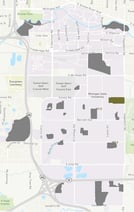Toumey Woodlot was originally acquired by the Bennett family in 1852. It was later obtained by Michigan State University from the Frank Bennett estate in 1939. Toumey woodlot has been the subject of Forestry Department-sponsored studies initiated in 1940, with observations in permanent quadrats at 10-year intervals. It was placed on the National Park Service Register of Natural Landmarks in 1976.
